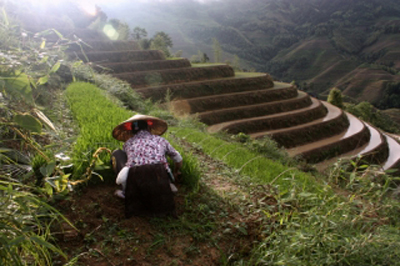
Effort to reduce agricultural pollution in reservoir benefits farmers and consumers, study shows
The brown, smog-filled skies that engulf Beijing have earned China a poor reputation for environmental stewardship. But a study by an international and interdisciplinary team of environmental scientists, including McGill’s Brian Robinson, has found that a government-run clean water program is providing substantial benefit to millions of people in the nation’s capital.
The Miyun reservoir, 100 miles north of Beijing, is the main water source for the city’s more than 20 million inhabitants. Greater agricultural demands and a decline in precipitation, among other factors, have cut the reservoir’s output by two-thirds since the 1960s. The water has also become increasingly polluted by fertilizer and sediment run-off, and poses a significant health risk.
Similar conditions shut down Beijing’s second largest reservoir in 1997; shortly after, officials began implementing a plan to prevent the same from happening to the Miyun reservoir.
The system follows the successful model established by New York City, in which the government and wealthier downstream consumers provide payouts to upstream farmers, who in turn modify their agricultural practices to improve water conditions.
In the case of China’s Paddy Land-to-Dry Land (PLDL) program, farmers are paid to convert their croplands from rice to corn, a solution that reduces both water consumption and pollution. Rice paddies are constantly flooded and are often situated on steep slopes, leading to significant fertilizer and sediment runoff. Corn, meanwhile, requires much less water, and fertilizer is more likely to stay in the soil.
Farmers earn almost six times more money growing rice than corn, so the government compensated farmers with funds that more than made up the difference. Door-to-door surveys revealed that the compensation program had mostly improved peoples’ livelihoods. Farmers were making more money and, because corn is a less time-intensive crop to grow, they had more time to pursue other activities.
The study estimates that fertilizer runoff declined sharply while the quantity of water available to downstream users in Beijing and surrounding areas increased.
Even though Beijing is essentially overpaying for corn, the program provides a significant net benefit to the city. The program cost about $1,330 per hectare of farmland to implement, but produced $2,020 per hectare of benefits, calculated as the value of increased water yield and improved water quality. (A hectare is equal to 2.47 acres.)
In fact, the researchers calculated that people on both ends of the deal benefit: upstream landowners’ ratio of benefits to costs is about 1.2 and downstream consumers of the water have about a 1.3 benefit-cost ratio. Altogether, the program has a benefit-cost ratio of 1.5.
While overall the program is successful, the door-to-door surveys showed that the program is probably not as successful as it could have been. “Farmers appear to use some of the cash payout from the program to purchase extra fertilizers, actually undercutting the original intent of the program. So the behavioural response to these kinds of policies is actually quite important, and is usually not taken into account when programs are designed,” said Robinson, an assistant professor of Geography at McGill and co-lead author of the study, with Hua Zheng of The Chinese Academy of Sciences.
“To be effective, programs should take into account these household responses, and build in program flexibility,” notes Robinson. Similar programs are already underway throughout Latin America and Africa. One of the key drivers of the PLDL’s success, according to the researchers, was the government’s willingness to adapt the program on the fly to meet the needs of the farmers. For example, while other compensation schemes have set hard long-term payout limits, when conditions in Miyun changed and farmers said they weren’t being fairly compensated, China upped the payments.
Although such projects are typically instituted based on the calculus that land remediation is a better long-term solution and less expensive than filtration plants – indeed, such considerations drove the PLDL – an added benefit is the opportunity to restore the natural landscape and other benefits that come from it.
Still, despite the many clear positives coming out of the PLDL so far, implementing these programs requires sensitive considerations.
“When is it right to tell people that they’ve got to change their way of life for the benefit of society?” said Gretchen Daily, a biology professor at Stanford and senior co-author on the study. “These are tough political and ethical issues, and it doesn’t always make sense for everyone. Yet resource pressures are intensifying everywhere. We’ve got to find ways of compensating people that are fair, and of opening new opportunities. In most cases, there will be no simple, ideal solution, as we can see with the controversy over New York City’s approach. These efforts underway in China today are important experiments with lessons for cities everywhere.”
The study was published online Sept. 3 in the Proceedings of the National Academy of Sciences. The report was co-authored by Zhi-Yun Ouyang of The Chinese Academy of Sciences; Yi-Cheng Liang and Mary Ruckelshaus of the Natural Capital Project; Stephen Polasky of the University of Minnesota and the Natural Capital Project; and Dong-Chun Ma and Feng-Chun Wang of the Beijing Water Science and Technology Institute.
To read the study, click here.
